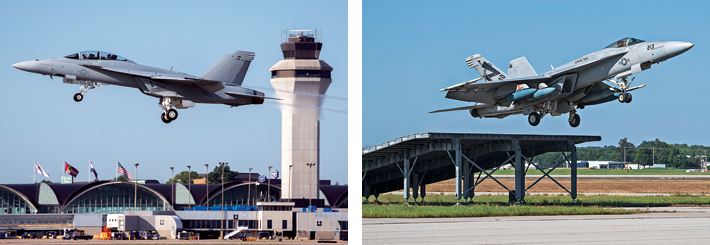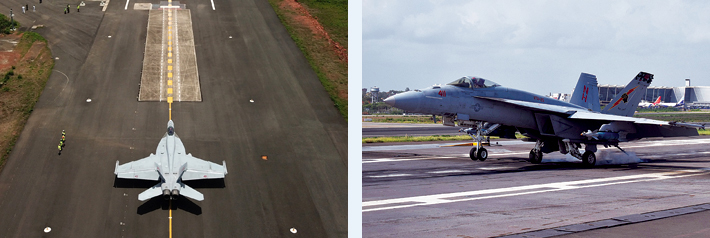INDIAN ARMED FORCES CHIEFS ON OUR RELENTLESS AND FOCUSED PUBLISHING EFFORTS

The insightful articles, inspiring narrations and analytical perspectives presented by the Editorial Team, establish an alluring connect with the reader. My compliments and best wishes to SP Guide Publications.

"Over the past 60 years, the growth of SP Guide Publications has mirrored the rising stature of Indian Navy. Its well-researched and informative magazines on Defence and Aerospace sector have served to shape an educated opinion of our military personnel, policy makers and the public alike. I wish SP's Publication team continued success, fair winds and following seas in all future endeavour!"

Since, its inception in 1964, SP Guide Publications has consistently demonstrated commitment to high-quality journalism in the aerospace and defence sectors, earning a well-deserved reputation as Asia's largest media house in this domain. I wish SP Guide Publications continued success in its pursuit of excellence.
The Premier Frontline Multi-role Naval Fighter
The aircraft is well placed to offer strategic advantages to the Indian Navy as it was specifically designed, from its inception, for carrier operations

The Indo-Pacific region is gaining prominence as a key geo-strategic intersection point for the world, and the Indian Navy will continue to play a pivotal role to defend India’s maritime interests, and in the Indo-Pacific region. This makes it imperative for the Indian Navy (IN) to strive to build worldclass, game-changing capabilities through collaboration and interoperability of defence assets. In this context, the Boeing F/A-18 Super Hornet Block III is well placed to offer strategic advantages to the Indian Navy.
The F/A-18 Super Hornet serves as the frontline multi-role fighter of the US Navy. More than 800 Super Hornets and Growlers (Electronic attack variant based on the Super Hornet platform) have been delivered and have accumulated more than 2.5 million flight hours across the fleet. The Block III configuration is well-suited to protect India’s maritime interests as it is built to meet the broadest range of missions while benefiting from the upgrades and knowledge related to US naval aviation. We anticipate the Super Hornet opening up opportunities for greater interoperability between the two navies for a more secure Indo-Pacific.
BINGING TRANSFORMATIVE, NEXT-GENERATION CAPABILITIES FOR INDIA
In the coming years, the Indian Navy will have two fully functioning aircraft carriers – INS Vikramaditya and the new indigenous aircraft carrier INS Vikrant (IAC-1). Even though these carriers were designed for Russian and indigenous aircraft, Boeing has conducted several studies over the last couple of years that demonstrate that the F/A-18 Super Hornet is fully compatible with both these carriers.
The F/A-18 Super Hornet was specifically designed, from its inception, for carrier operations. One of the main benefits of this is that the aircraft has the ability to fold its wings, allowing for better utilisation of deck space on the aircraft carrier. Boeing has conducted a thorough study and analysis that optimises the number of Super Hornets that can fit aboard INS Vikramaditya and INS Vikrant, as well as optimises the cyclic operations from those carriers leading to high sortie generation rates.

Boeing has also developed a capability specifically for the F/A-18 Super Hornet Block III that will allow for the faster movement of the aircraft between the flight deck and hangar deck without having to remove or modify any part of the aircraft. This capability is compatible with the current elevator/lift configuration aboard Indian aircraft carriers.
Block III’s networking enables the F/A-18 Super Hornet to be interoperable with other US assets of the Indian Navy (IN), such as the P-8I and MH-60R. For example, F/A-18s of the IN can potentially share data with P-8Is of the IN or P-8 of US Navy and Royal Australian Air Force to significantly improve the capability of the partner countries for helping secure the Indo-Pacific.
Recently, there have been tremendous advancements in unmanned systems that are to be used in a naval aviation environment. In the future, as IN inducts such systems, both the single-seat and two-seat versions of the Super Hornet on the Indian Navy (IN) carrier will allow interfacing with unmanned carrier-borne systems more effectively.
Another important fact to note is that the two-seater carrier compatible variant of the Super Hornet offers several unique advantages to the IN including flexibility, higher utilisation of the fleet, and the ability to embark certain missions from the carrier that benefit from having the second crew member. Additionally, two-seater F/A-18 Super Hornets can be used as trainers (ashore and on the carrier) and as fully capable fighters, operational from carrier and from land bases. Thus, IN will get tremendous flexibility and a higher asset utilisation rate due to the carrier compatible variant of the two-seater variant of the F/A-18.
The Super Hornet has successfully conducted eight ski-jumps in various weights and configurations during previous tests held at Naval Air Station (NAS) Patuxent River in Maryland in late 2020. The recent test in India, continued from where the previous tests left off to further demonstrate the Super Hornet’s ability to operate from a short takeoff but arrested recovery (STOBAR) aircraft carrier to meet or exceed the test requirements and be the best fit for the Indian Navy’s future fighter force.
BY INDIA, FOR INDIA
Boeing will build on the success of its existing defence programmes that we are executing for the Indian Air Force and Indian Navy today. Through the ‘By India-For India’ sustainment programme, Boeing will deliver complete value over the lifecycle of the Super Hornet by developing capabilities that can sustain the platform in India.
Boeing supports the mission readiness of the C-17, P-8I, AH-64 Apache and CH-47 Chinook fleets of the Indian Navy and Indian Air Force and is delivering high rates of aircraft availability to its Indian customers.
The Super Hornet is powered by the GE F-414 engine that has clocked cumulatively more than 5 million hours. The same family of engines is powering India’s indigenous Light Combat Aircraft inducted by the Indian Air Force. The commonality in engines would create scale efficiencies for potential sustainment opportunities in India in the future.
Boeing F/A-18 Super Hornet Successfully Completes Operational Demonstrations in India
- Completed multiple ski-jumps, roll-in and fly-in arrestments, as well as performance flights in a variety of weights and configurations
- F/A-18 Demonstrates Carrier Compatibility to Indian Navy requirements

Boeing’s F/A-18 Super Hornet successfully completed operational demonstration tests at Indian Naval Station Hansa in Goa, India, and reinforced the Super Hornet’s ability to effectively and safely operate off Indian Navy carriers.
Two US Navy F/A-18E Super Hornets completed multiple ski-jumps, roll-in and fly-in arrestments, as well as performance flights, in a variety of weights in the air-to-air, air-to-ground, and air-tosurface configurations, meeting the Indian Navy test requirements.
“The Boeing team was privileged to showcase the F/A-18 Super Hornet’s compatibility with Indian carriers in Goa,” said Alain Garcia, Vice President, India business development Boeing Defense, Space & Security and Global Services. “As the premier frontline multi-role naval fighter, the F/A-18 Super Hornet is one of the world’s most proven and affordable multi-role fighters and continues to evolve with the development of the next-generation Block II capability which will be game-changing for India.”
“With the Super Hornet Block II, the Indian Navy would not only get the most advanced platform but would also benefit from tactics, upgrades and knowledge related to the naval aviation ecosystem that the US Navy offers,” he added.
The tests followed eight ski-jumps in various weights and configurations during previous tests held at Naval Air Station (NAS) Patuxent River in Maryland in late 2020 that demonstrated the Super Hornet’s ability to operate from a short takeoff but arrested recovery (STOBAR) aircraft carrier.
F/A-18 SUPER HORNET INDIA FACTSHEET
- As the US Navy’s frontline fighter, with over 800 aircraft delivered around the world and over 2.5 million flight hours flown, the Super Hornet Block II offers opportunities for cooperation and interoperability between the United States and India navies.
- The Super Hornet Block II will come with advanced networking and open architecture design that will allow Super Hornet to be interoperable with the Indian Navy’s P-8I and other USorigin assets and rapidly accept new technology to stay ahead of emerging threats.
- Boeing and the US Navy made multi-billion-dollar investments in infusing new technologies in the Super Hornet Block II, including increasing the life of the airframe to 10,000 hours from 6,000 hours of Block II, radar cross-section improvements, and advanced crew station which includes a large area display.
- The F/A-18 Super Hornet has been designed and built for carrier operations, and is fully compliant with INS Vikramaditya and INS Vikrant aircraft carriers. F/A-18 will be able to operate on the deck, in the hangar and on the lifts of the Indian Navy’s aircraft carriers.
- The F/A-18 can carry four anti-ship missiles (Harpoon).
- The two-seater carrier compatible variant of the Super Hornet offers several unique advantages to the Indian Navy including flexibility, higher utilisation of the fleet, and the ability to embark on certain missions from the carrier that benefit from having a second crew member. Additionally, two-seater F/A-18 Super Hornets can be used as trainers (ashore and on the carrier) and as fully capable fighters, operational from the carrier and from land bases.
- Designed as a carrier-based fighter for high- loading, high stress operations, the F/A-18E/F Super Hornet Block II requires minimal support equipment and has the lowest cost per flight hour to operate with high mission readiness rates.
- Depending on the Indian Navy’s requirements, Boeing’s “By India–For India Sustainment Programme” that is built on other successful sustainment programmes that Boeing is executing for the Indian Air Force and the Indian Navy today will allow for capabilities development in India to sustain the F/A-18 Super Hornet.
- Powered by the GE F-414 engine that has clocked more than 5 million hours, the F/A-18 Super Hornet Block II uses the same family of engines that is powering India’s indigenous Light Combat Aircraft (LCA); that has already been inducted by the Indian Air Force. The commonality in engines will create scale efficiencies for potential sustainment opportunities in the future.





